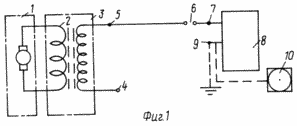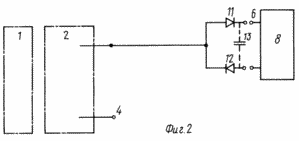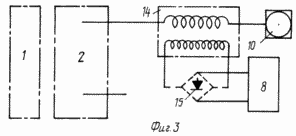| Start of section
Production, amateur Radio amateurs Aircraft model, rocket-model Useful, entertaining |
Stealth Master
Electronics Physics Technologies Inventions |
Secrets of the cosmos
Secrets of the Earth Secrets of the Ocean Tricks Map of section |
|
| Use of the site materials is allowed subject to the link (for websites - hyperlinks) | |||
Navigation: => |
Home / Patent catalog / Catalog section / Back / |
|
INVENTION
The patent of the Russian Federation RU2108649
![]()
METHOD OF POWER SUPPLY OF ELECTROTECHNICAL DEVICES
AND DEVICE FOR ITS IMPLEMENTATION
The name of the inventor: Avramenko Stanislav Viktorovich
The name of the patent holder: Avramenko Stanislav Viktorovich
Address for correspondence:
Date of commencement of the patent: 1995.04.11
The invention relates to methods for supplying electrical devices and devices for their implementation. The invention is aimed at solving the problem of creating devices that are free from significant ohmic energy losses in the connecting wires. According to the method, a power consumer is connected to one of the high voltage terminals of a high-frequency transformer, the low-voltage winding of which is connected to an alternating voltage generator with tunable frequency. By changing the frequency of the generator, resonance oscillations are created, accompanied by the transfer of energy to the consumer. The device contains an alternating voltage generator with adjustable frequency, a high-frequency transformer, one of the terminals of high-voltage winding of which is connected to one of the input terminals of the consumer, and the other end is isolated. The power supply terminal can be provided with matching means to the consumer, for example, in the form of a rectifier unit or a transformer converter.
DESCRIPTION OF THE INVENTION
The invention relates to methods for supplying electrical devices and devices for its implementation.
A method is known for supplying electrical devices by placing the powered device in an induction coil connected to an alternating current source.
The device implementing this method contains a source of alternating voltage, an induction coil, matching elements [1].
Although in this method and device the energy exchange between the source and the receiver is carried out by bias currents, conduction currents flow along the closed loop in the feeder itself, which is due to ohmic losses in this circuit and, accordingly, the heating of its elements.
The prototype of this proposal is the method of supplying the electrical device and the device for its implementation by supplying electricity through a two-wire line, depending on the parameters of the source of electricity and the receiver, use certain matching devices (transformers, amplifiers, etc.) [2].
The realization of this method on a two-wire line forming a closed loop is inevitably associated with ohmic losses in the connecting wires, as a result of which it is necessary to increase the metal capacitance of the conducting lines.
The present invention is directed to solving the problem of creating a method for supplying electrical devices and a device for carrying it out, characterized by low ohmic losses in the connecting wires and the possibility of transferring high energies through the conductor lines of transmission with a small cross-section of conductors.
This is achieved by powering the electrical devices by connecting one of its input terminals to one of the terminals of the high-voltage section of the high-frequency transformer of the converter connected to an alternating voltage source, while selecting the frequency of the alternating voltage source to achieve resonance oscillations in the generated electrical circuit.
The device implementing this method is an alternating voltage generator with adjustable frequency, including a frequency changing means, a high-frequency transformer, one terminal of the high-voltage section of which is isolated, and the second one is intended for supplying power to the consumer.
 |
 |
 |
In Fig. 1 shows the general scheme of the device implementing the proposed method of supplying electrical devices; In Fig. 2 is a schematic diagram of the power supply of ac receiving devices; In Fig. 3 - variants of supply of receiving devices with alternating or direct current. |
Referring to Fig. 1 to a variable frequency alternating voltage generator 1 including a frequency change means (not shown), a low-voltage winding 2 of a high-frequency transformer converter 3 is connected. One of the terminals 4 of its high-voltage winding is isolated and the second terminal 5 is provided with means 6 for connecting to one From the input terminals 7 of the consumer 8 of electromagnetic energy. The second consumer terminal 9 is either grounded or connected to a capacitance of 10.
In the case of DC supply of electrical devices, FIG. 2, pin 5 is provided with two diodes 11, 12, providing the passage of a unidirectional current in a closed loop formed by diodes 11, 12 and the consumer. In parallel with the diodes, a capacitor 13 can be connected. Referring to FIG. 3, the terminal 5 is connected to the primary winding of the transformer converter 14, the secondary winding of which is connected to the consumer either directly or via a rectifying device 15.
The high-frequency transformer converter can be either a low-voltage (outside) and a high-voltage (inside) coil wound coaxially on the common frame, while an unclosed magnetic core can be used in either case.
METHOD REALIZES AS FOLLOWED
To the alternating voltage generator 1 with adjustable frequency, the low-voltage winding of the transformer converter 3 is connected, and one of the input terminals 7 of the consumer 8 is connected to one of the terminals of the high-voltage winding. The second terminal of the high-voltage winding is isolated. After this, the frequency of the alternating voltage generator is changed. At a certain frequency, which lies predominantly within the range of 0.5-100 KHz, electric resonance oscillations appear in the formed electric circuit, which is immediately evident, for example, from the ignition of an electric bulb used as an electric energy consumer, or by the rotation of a direct current motor connected according to FIG. 2. The occurrence of electrical fluctuations indicates the transfer of energy to the consumer. Since the power consumers are powered by an unconnected electrical circuit, it can be assumed that the process of electric power transmission is carried out according to the therhythmic model described by Academician V.F. Mitkevich in his monograph "The Magnetic Flux and Its Transformations" - Publishing House of the USSR AS, Ml, 1946.
A characteristic feature of this invention is that the energy transfer of the generator 1 in the mode of resonant oscillations is not accompanied by the release of heat in the lead-in conductor 5, which makes it possible to use conductors of small cross-section without losing power for heating them.
It should be said that the transfer of energy on one wire was demonstrated by Nikolai Tesla in 1894. However, no specific information on the implementation of this experiment has been preserved.
CLAIM
1. A method for supplying electrical devices using an alternating voltage generator connected to a consumer, characterized in that the generator voltage is applied to the low-voltage winding of the high-frequency transformer converter, and one of the high voltage winding terminals of this converter is connected to one of the output terminals of the electrotechnical device being fed, By changing the oscillator frequency, resonance oscillations in the formed electric circuit are achieved.
2. A power supply device for electrical devices comprising an alternating voltage generator and means for transmitting electric power to a consumer, characterized in that the means for transmitting electric power to a consumer is a high-frequency transformer converter whose primary low-voltage winding is connected to an alternating voltage generator, one of the terminals of the secondary high-voltage winding is provided with a coupling means It is connected to one of the input terminals of the consumer of electricity, and the other terminal of this winding is isolated, and the alternating voltage generator is provided with means for changing the frequency.
3. The device according to claim 2, characterized in that it is provided with a matching unit arranged in a diode circuit such that the uninsulated terminal of the high-voltage winding is connected to the common point of the anode of the first of the diodes and the cathode of the second diode, wherein the cathode of the first diode and the second diode anode are provided Means for connection to the consumer of electric power.
4. The device of claim 2, characterized in that it is provided with a transformer converter whose primary winding is connected to the uninsulated terminal of the high-frequency winding, and the secondary winding is connected to the consumer of electric power.
print version
Publication date 16.02.2007gg




Comments
When commenting on, remember that the content and tone of your message can hurt the feelings of real people, show respect and tolerance to your interlocutors even if you do not share their opinion, your behavior in the conditions of freedom of expression and anonymity provided by the Internet, changes Not only virtual, but also the real world. All comments are hidden from the index, spam is controlled.